Chem 104 experiment 6 Study guides, Class notes & Summaries
Looking for the best study guides, study notes and summaries about Chem 104 experiment 6? On this page you'll find 21 study documents about Chem 104 experiment 6.
Page 2 out of 21 results
Sort by
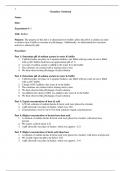
-
CHEM 104 Experiment 5: Buffers - Portage Learning
- Exam (elaborations) • 4 pages • 2023
- Available in package deal
-
- $13.49
- + learn more
CHEM 104 Experiment 5: Buffers - Portage Learning Purpose: The purpose of this lab is to determine how buffers affect the pH of a solution in order to observe how a buffer is resistant to pH changes. Additionally, we determined how enzymes activity is affected by pH. Procedure: Part 1: Determine pH of sodium acetate in water & buffer 1. 2 pH electrodes are place in 2 separate beakers, one filled with tap water & one is filled with a pH 7 buffer (both have an approximate pH of 7) 2. A scoop of s...
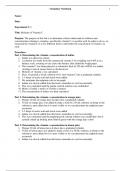
-
CHEM 104 Experiment 4: Molarity of Vitamin C - Portage Learning
- Exam (elaborations) • 3 pages • 2023
- Available in package deal
-
- $13.49
- + learn more
CHEM 104 Experiment 4: Molarity of Vitamin C - Portage Learning Purpose: The purpose of this lab is to determine a better understand of solutions and concentrations relating to vitamins, specifically vitamin C or ascorbic acid. In order to do so, we measured the vitamin C in a few different fruits to determine the concertation of vitamin c in each. Procedure: Part 1: Determining the vitamin c concentration of iodine 1. Iodine was placed in a buret. 2. A solution was made from the commercial vit...
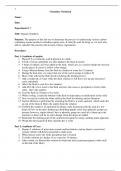
-
CHEM 104 Experiment 7 Organic Synthesis - Portage Learning
- Exam (elaborations) • 4 pages • 2023
- Available in package deal
-
- $14.49
- + learn more
CHEM 104 Experiment 7 Organic Synthesis - Portage Learning Purpose: The purpose of this lab was to determine the process of synthesizing various carboncontaining organic products including aspirin, urea, & salicylic acid. In doing so, we were also able to calculate the percent yield in each of these experiments. Procedure: Part 1: Synthesis of aspirin 1. Placed 2.0 g of salicylic acid & placed it in a flask 2. 5.0 mL of acetic anhydride was then added to the flask & mixed 3. 5 drops of sulfuric...
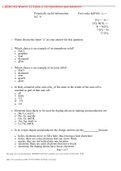
-
CHEM 102 Winter 12 Exam 2 (A) Questions and Answers,100% CORRECT
- Exam (elaborations) • 9 pages • 2023
-
- $14.99
- + learn more
CHEM 102 Winter 12 Exam 2 (A) Questions and Answers Potentially useful information: First order half-life: t1/2 = ln2 / k [A]t = - kt + [A]o ln[A]t = - kt + ln[A]o 1/[A]t = kt +1/[A]o 1. Please choose the letter “a” as your answer for this question. 2. Which choice is an example of an amorphous solid? a. NaCl b. graphite c. iron d. diamond e. glass 3. Which choice is an example of an ionic solid? a. NaCl b. diamond c. iron d. quartz e. glass 4. In body-centered cubi...
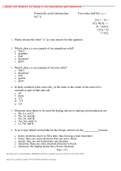
-
CHEM 102 Winter 12 Exam 2 (A) Questions and Answers,100% CORRECT
- Exam (elaborations) • 9 pages • 2023
-
- $14.99
- + learn more
CHEM 102 Winter 12 Exam 2 (A) Questions and Answers Potentially useful information: First order half-life: t1/2 = ln2 / k [A]t = - kt + [A]o ln[A]t = - kt + ln[A]o 1/[A]t = kt +1/[A]o 1. Please choose the letter “a” as your answer for this question. 2. Which choice is an example of an amorphous solid? a. NaCl b. graphite c. iron d. diamond e. glass 3. Which choice is an example of an ionic solid? a. NaCl b. diamond c. iron d. quartz e. glass 4. In body-centered cubi...
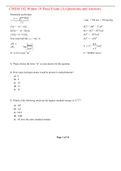
-
CHEM 102 Winter 18 Final Exam (A) Questions and Answers,100% CORRECT
- Exam (elaborations) • 19 pages • 2023
-
- $16.49
- + learn more
CHEM 102 Winter 18 Final Exam (A) Questions and Answers Potentially useful data: x 1 atm = 760 torr = 760 mm Hg 2 a [A]t = – kt + [A]o ΔG° = ΔH° – T ΔS° ln[A]t = – kt + ln[A]o ΔG = ΔG° + RT ln Q 1/[A]t = kt +1/[A]o ΔG° = – RT ln K First order half-life: t1/2 = ln2 / k ΔG° = – nFE° pH pKa log base acid E E R T ln Q n F R = 8.314 J mol-1 K-1 F = 96500 C/mol e- 1. Please choose the letter “A” as your a...
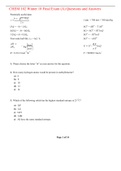
-
CHEM 102 Winter 18 Final Exam (A) Questions and Answers,100% CORRECT
- Exam (elaborations) • 19 pages • 2023
-
- $15.99
- + learn more
CHEM 102 Winter 18 Final Exam (A) Questions and Answers Potentially useful data: x 1 atm = 760 torr = 760 mm Hg 2 a [A]t = – kt + [A]o ΔG° = ΔH° – T ΔS° ln[A]t = – kt + ln[A]o ΔG = ΔG° + RT ln Q 1/[A]t = kt +1/[A]o ΔG° = – RT ln K First order half-life: t1/2 = ln2 / k ΔG° = – nFE° pH pKa log base acid E E R T ln Q n F R = 8.314 J mol-1 K-1 F = 96500 C/mol e- 1. Please choose the letter “A” as your a...
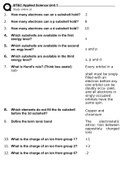
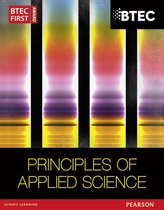
-
BTEC APPLIED SCIENCE: UNIT 11 - Learning Aim D
- Exam (elaborations) • 61 pages • 2023
-
- $13.49
- + learn more
1. How many electrons can an s subshell hold? 2 2. How many electrons can a p subshell hold? 6 3. How many electrons can a d subshell hold? 10 4. Which subshells are available in the first energy level? 5. Which subshells are available in the second en- ergy level? 6. Which subshells are available in the third energy level? s s and p s, p and d 7. What is Hund's rule? (Think bus seats!) Every orbital in a sub- shell must be singly filled with an electron before any one orbital can be d...

-
Chem 104 Module 1 -Module 6 Exam (elaborations)
- Exam (elaborations) • 32 pages • 2023
-
- $15.49
- + learn more
Chem 104 Module 1 -Module 6 Exam (elaborations) Module 1: Question 1 In the reaction of gaseous N2 O5 to yield NO2 gas and O2 gas as shown below, the following data table is obtained: 2 N2 O5 (g) → 4 NO2 (g) + O2 (g) Data Table #2 Time (sec) [N2 O5 ] [O2 ] 0 0.300 M 0 300 0.272 M 0.014 M 600 0.224 M 0.038 M 900 0.204 M 0.048 M 1200 0.186 M 0.057 M 1800 0.156 M 0.072 M 2400 0.134 M 0.083 M 3000 0.120 M 0.090 M 1. Using the [O2 ] data from the table, show the calculation of the instantaneous ra...
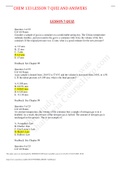
-
CHEM 133 LESSON 7 QUIZ AND ANSWERS,100% CORRECT
- Exam (elaborations) • 8 pages • 2021
-
- $14.49
- + learn more
CHEM 133 LESSON 7 QUIZ AND ANSWERS LESSON 7 QUIZ Question 1 of 25 4.0/ 4.0 Points Consider a sample of gas in a container on a comfortable spring day. The Celsius temperature suddenly doubles, and you transfer the gas to a container with twice the volume of the first container. If the original pressure was 12 atm, what is a good estimate for the new pressure? A. 5.5 atm B. 12 atm C. 3 atm D. 6.4 atm E. 15 atm Feedback: See Chapter 09 Question 2 of 25 4.0/ 4.0 Points A gas sa...

$6.50 for your textbook summary multiplied by 100 fellow students... Do the math: that's a lot of money! Don't be a thief of your own wallet and start uploading yours now. Discover all about earning on Stuvia


